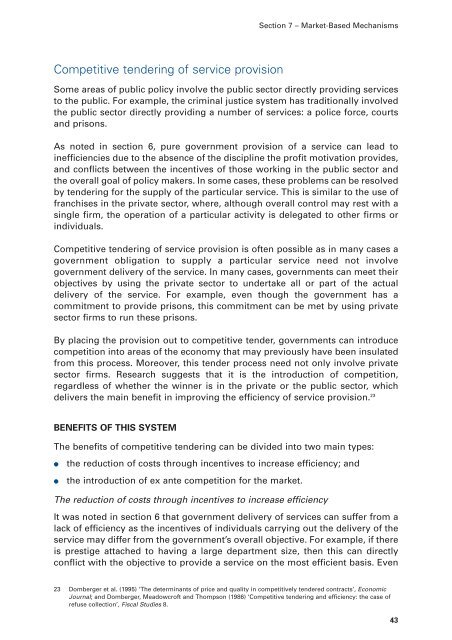Public Policy: Using Market-Based Approaches - Department for ...
Public Policy: Using Market-Based Approaches - Department for ...
Public Policy: Using Market-Based Approaches - Department for ...
You also want an ePaper? Increase the reach of your titles
YUMPU automatically turns print PDFs into web optimized ePapers that Google loves.
Competitive tendering of service provision<br />
Some areas of public policy involve the public sector directly providing services<br />
to the public. For example, the criminal justice system has traditionally involved<br />
the public sector directly providing a number of services: a police <strong>for</strong>ce, courts<br />
and prisons.<br />
As noted in section 6, pure government provision of a service can lead to<br />
inefficiencies due to the absence of the discipline the profit motivation provides,<br />
and conflicts between the incentives of those working in the public sector and<br />
the overall goal of policy makers. In some cases, these problems can be resolved<br />
by tendering <strong>for</strong> the supply of the particular service. This is similar to the use of<br />
franchises in the private sector, where, although overall control may rest with a<br />
single firm, the operation of a particular activity is delegated to other firms or<br />
individuals.<br />
Competitive tendering of service provision is often possible as in many cases a<br />
government obligation to supply a particular service need not involve<br />
government delivery of the service. In many cases, governments can meet their<br />
objectives by using the private sector to undertake all or part of the actual<br />
delivery of the service. For example, even though the government has a<br />
commitment to provide prisons, this commitment can be met by using private<br />
sector firms to run these prisons.<br />
By placing the provision out to competitive tender, governments can introduce<br />
competition into areas of the economy that may previously have been insulated<br />
from this process. Moreover, this tender process need not only involve private<br />
sector firms. Research suggests that it is the introduction of competition,<br />
regardless of whether the winner is in the private or the public sector, which<br />
delivers the main benefit in improving the efficiency of service provision. 23<br />
BENEFITS OF THIS SYSTEM<br />
The benefits of competitive tendering can be divided into two main types:<br />
● the reduction of costs through incentives to increase efficiency; and<br />
● the introduction of ex ante competition <strong>for</strong> the market.<br />
The reduction of costs through incentives to increase efficiency<br />
Section 7 – <strong>Market</strong>-<strong>Based</strong> Mechanisms<br />
It was noted in section 6 that government delivery of services can suffer from a<br />
lack of efficiency as the incentives of individuals carrying out the delivery of the<br />
service may differ from the government’s overall objective. For example, if there<br />
is prestige attached to having a large department size, then this can directly<br />
conflict with the objective to provide a service on the most efficient basis. Even<br />
23 Domberger et al. (1995) ‘The determinants of price and quality in competitively tendered contracts’, Economic<br />
Journal; and Domberger, Meadowcroft and Thompson (1986) ‘Competitive tendering and efficiency: the case of<br />
refuse collection’, Fiscal Studies 8.<br />
43
















